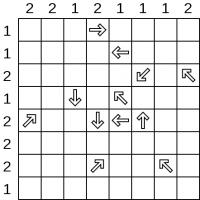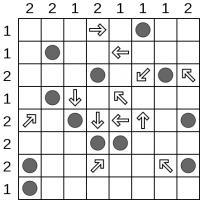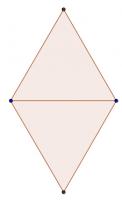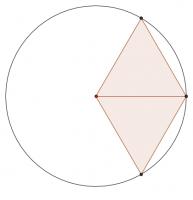Puzzles
Shinro
In the grid below, there are 12 holes hidden in the grid. Each of the arrows is pointing towards at least one hole. None of the arrows covers a hole.
For example, the arrow in the first row tells you that at least one of the last four squares in that row contains a hole.
Find the location of all 12 holes.
Integer part
Let \(\lfloor x\rfloor \) denote the integer part of \(x\) (eg. \(\lfloor 7.8\rfloor =7\)).
When are the following true:
a) \(\lfloor x+1\rfloor = \lfloor x\rfloor + 1\)
b) \(\lfloor nx\rfloor = n\lfloor x\rfloor\) (where \(n\) is an integer)
c) \(\lfloor x+y\rfloor = \lfloor x\rfloor +\lfloor y\rfloor \)
d) \(\lfloor xy\rfloor = \lfloor x\rfloor \lfloor y\rfloor \)
Show answer & extension
Hide answer & extension
a) Always
b) When \(n<\frac{1}{f_x}\), where \(f_x\) is the fractional part of \(x\).
c) When the fractional parts of \(x\) and \(y\) add up to less than one.
d) Let \(f_x\) and \(f_y\) be the fractional parts of \(x\) and \(y\) (respectively).
$$\lfloor xy\rfloor = \lfloor (\lfloor x\rfloor +f_x)(\lfloor y\rfloor +f_x)\rfloor $$
$$=\lfloor \lfloor x\rfloor \lfloor y\rfloor +f_x\lfloor y\rfloor +f_y\lfloor x\rfloor +f_yf_x\rfloor $$
$$=\lfloor x\rfloor \lfloor y\rfloor +\lfloor f_x\lfloor y\rfloor +f_y\lfloor x\rfloor +f_yf_x\rfloor $$
This will be equal to \(\lfloor x\rfloor \lfloor y\rfloor \) when \(\lfloor f_x\lfloor y\rfloor +f_y\lfloor x\rfloor +f_yf_x\rfloor =0\).
For this to be true, it is necessary (but not sufficient) that \(f_y<\frac{1}{x}\) and \(f_x<\frac{1}{y}\).
Extension
Show that
$$\lfloor x\rfloor +\left\lfloor x+\frac{1}{n}\right\rfloor +\left\lfloor x+\frac{2}{n}\right\rfloor +...+\left\lfloor x+\frac{n-1}{n}\right\rfloor =\lfloor nx\rfloor.$$
Make the sums
Put the digits 1 to 9 (using each digit exactly once) in the boxes so that the sums reading across and down are correct. The sums should be read left to right and top to bottom ignoring the usual order of operations. For example, \(4+3\times2\) is 14, not 10.
| + | | - | | = 4 |
| + | | - | | × | |
| - | | × | | = 27 |
| - | | × | | ÷ | |
| × | | ÷ | | = 16 |
=
2 | | =
8 | | =
6 | |
Show answer & extension
Hide answer & extension
| 1 | + | 5 | - | 2 | = 4 |
| + | | - | | × | |
| 7 | - | 4 | × | 9 | = 27 |
| - | | × | | × | |
| 6 | × | 8 | - | 3 | = 16 |
=
2 | | =
8 | | =
6 | |
Extension
Put the digits 1 to 9 (using each digit exactly once) in the boxes so that the sums reading across and down are correct.
| + | | - | | = 5 |
| - | | - | | - | |
| + | | ÷ | | = 5 |
| + | | ÷ | | × | |
| + | | × | | = 99 |
=
0 | | =
1 | | =
18 | |
Rotating round table
At a large dinner, 24 people are to sit evenly spaced around a round table. Place cards are laid to show where everyone should sit. Unfortunately nobody notices the name cards and the guests sit down with nobody in the correct seat.
Show that it is possible to rotate the table so that at least two people will be in the correct seats.
Show answer & extension
Hide answer & extension
Let \(p(n)\) denote the number of people in the correct seat when the table is rotated by \(n\) people. From the question, we know that:
$$p(0)=0$$
As every guest can be put into the correct place by one rotation, we know that:
$$p(0)+p(1)+...+p(23)=24$$
As \(p(0)=0\):
$$p(1)+...+p(23)=24$$
This sum has 23 positive integers adding up to 24, so one of the rotations must lead to at least two people being in the correct places.
Extension
If the 24 guests sat randomly and one person was in the correct seat, could you still rotate the table so that two people are correctly seated?
Balanced sets
A set of points in the plane is called 'balanced' if for any two points \(A\) and \(B\) in the set, there is another point \(C\) in the set such that \(AC=BC\) (here \(AC\) is the distance between \(A\) and \(C\)).
For all \(n\geq3\), find a balanced set of \(n\) points.
Show answer
Hide answer
If \(n\) is odd, the vertices of a regular \(n\)-gon are balanced.
If \(n\) is even, a balanced set can be constructed as follows:
If \(n=4\), this set is balanced (both the triangles are equilateral):
Draw a triangle with its centre at one of the points, going through the other three points:
For \(n>4\), repeatedly add a two new points on the circle which form an equilateral triangle with the centre. For example, for \(n=6\), this set is balanced:
And for \(n=8\), this set is balanced:

121
Find a number base other than 10 in which 121 is a perfect square.
Ticking clock
Is there a time of day when the hands of an analogue clock (one with a second hand that moves every second instead of moving continuously) will all be 120° apart?
Show answer & extension
Hide answer & extension
The second hand will always be pointing at one of the 60 graduations. If the minute and hour hand are 120° away from the second hand they must also be pointing at one of the graduations. The minute hand will only be pointing at a graduation at zero seconds past the minute, so the second hand must be pointing at 0. Therefore the hand are either pointing at: hour: 4, minute: 8, second: 0; or hour: 8, minute: 4, second: 0. Neither of these are real times, so it is not possible
Extension
If the second hand moves continuously instead of moving every second, will there be a time when the hands of the clock are all 120° apart?































